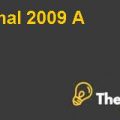
Adelphia Communications Corp. (ACC)
1. Introduction:
The case presents a company, named “Adelphia Communications Corp.” (ACC), well known for its place in the cable industry, established by John Rigas and incorporated in 1972. The company has filed for bankruptcy under Chapter 11 in 2002 and the case is under the due process of being finalized. Under Chapter 11 filing, ACC’s reorganization plan as a standalone company has been shifted by the creditors to a liquidations/asset selling alternative so as to fetch their stake in the minimum time. Bidding for the assets of ACC is in the final stage by April 2005 and three major bids have emerged with the passage of time.
2. Problem Statement:
Following points need to be analyzed in case of ACC;
- Mistakes of Rigas Family Management and issues, if any, in the governance structure of ACC.
- Viability of Adelphia’s business just prior to its bankruptcy filing and any feasible option available, other than a Chapter 11 filing.
- Evaluate and suggest any one from the three main competing offers to purchase Adelphia’s assets.
- Evaluate in light of these offers, whether management should reconsider its selling plan rather than pursuing a traditional chapter 11 stand-alone reorganization plan.
3. Analysis / Result:
Let us consider and analyze the above mentioned points. Also refer to the Excel Sheet – Adelphia;
Mistakes of Rigas Family Management and issues in the governance structure.
As the Rigas family has a dominant position on the board of ACC, therefore it is in the position of enforcing important and strategic decisions/transactions. Thus to support Rigas’ intention to increase control over ACC, Rigas family members indulged ACC in various Co-borrowing arrangements to fund their intention to increase its holding in ACC. This was done due the reason that Rigas family lacks sufficient collaterals to borrow funds for its task of increasing ACC’s stake. This co-borrowing limit continuously increased over the passage of time.
As per these Co-borrowing arrangement, ACC is also liable for the funds obtained under these arrangements and utilized by Rigas Family for its private investments and purchasing the stake of ACC for increased control. For this purpose, ACC also has to bear a lien over its stock as Rigas family lacks sufficient collaterals for this purpose.
Thus with the continuous increase in the borrowings, creditors stake in the group was also increasing which is one of the influencing feature forcing towards ACC’s liquidation.
As Class B shares were the intended purchase, Rigas has been continuously accumulating the shares and due to the reason of share prices being high during these accumulating periods, thus the amount used for this purchase also posed sufficient burden over the group’s borrowing.
The window dressing exposed after the change in management i.e. up to 33% in increased operating profits, dumped expense receipts, improper capitalization of expenses shows the performance of business of ACC which was hidden from the investors as well as from all outside stakeholders including the regulators. Simultaneously, rates charged for monthly subscription fee were without considering the impact of inflation.
Rigas family was also involved in utilizing the groups centralized funds in its private holdings, investments and activities as purchasing “Buffalo Sabres”, developing golf club, producing movie as well as the generous acts of social benefits and community help of its home town, Coudersport.
ACC has also been keen on acquiring subscribers for its cable services by way of acquiring entities and paying high prices for its acquisitions even making acquisitions at a record setting level. This generous use of funds poses additional burden on ACC’s financial position. Due to such use of funds for acquisitions and purchasing the controlling interest in ACC for Rigas family and other above-stated purposes, ACC was highly indebted which can be well analyzed by the following graph, showing that the debt burden in 1998 was $3.5 Billion but it increased up to the level of $9.3 Billion in 1999, i.e. more than 260% increase in the debt level from the last year.
As the governance structure of ACC has been sufficiently under the control of Rigas family and their close friends on the board and strategic level of the company, therefore there were no substantial forces present for the opposition of such decisions of Rigas. Thus the governance structure of Rigas was in a need of an active involvement by independent executives representing the stake of public investors as well.
How could such a structure persist over such a long time without being identified:
As discussed above, the governace of ACC was under substantial control of Rigas family, thus there was no one else than the Rigas faimly and their friends, to challenge such decisions of Rigas family made mostly for their personal and private interests at the cost of ACC, a public company.
The auditors of ACC were also to be asked for their negligence which made them unable to identify such facts and bring in market the accounting errors, privately executed beneficial activities with company’s funds and obligations undertaken due to such decisions of Rigas Family.
As the management has been pursuing a centralised pool for managing the cash and fund system for all the entities in the ACC’s group as well as the private holdings of Rigas family, thus there were ambiguities as well as intentional efforts (later identified by changed management) to complicate the matters and hance avoid its exposure to the outsiders.
Viability of Adelphia’s business just prior to its bankruptcy filing (ignoring fraud).
As the management of ACC changes on the resignation of the Rigas family, the issues which were hidden over a prolonged period came in front of public. The accounting frauds made at the time of the Rigas family’s control over ACC are rectified in the restated finanial statements issued by the changed management. This restated financial statement of 2001 and 2001 showed that ACC made billions of loss which showed the productivity of ACC’s business. Over the period of time, the increasing indebtness of ACC also disclosed that the business performance of ACC was getting endangered due to unfavourable decisions taken over the period of time. However if the overall industry of cable operations is examined, it can be analyzed that the industry itself has a booming potential and hence the business value of ACC could be on a higher side, rather than getting such billions of losses.
The Gross profit/loss percentage of ACC was 160% gross loss over the revenues and 184% net loss over the total revenues of ACC in 2001 and 145% gross loss and 220% net loss for 2002 respectively as stated by the changed management. However, the reportings as per the ACC’s management under Rigas control showed Gross profit/loss percentage of ACC as for 1999, 11% of gross profit and 22% of net loss over the total revenues of ACC in 1999 and for 2000, it showed a gross profit of 7% and 21% of net loss respectively (as shown in Graph)....
This is just a sample partial case solution. Please place the order on the website to order your own originally done case solution
The Case Study authored by Stuart C. Gilson, Belen Villalonga Source: Harvard Business School 37 pages. Publication Date: October 19, 2007. Prod. #: 208071-PDF-ENG












